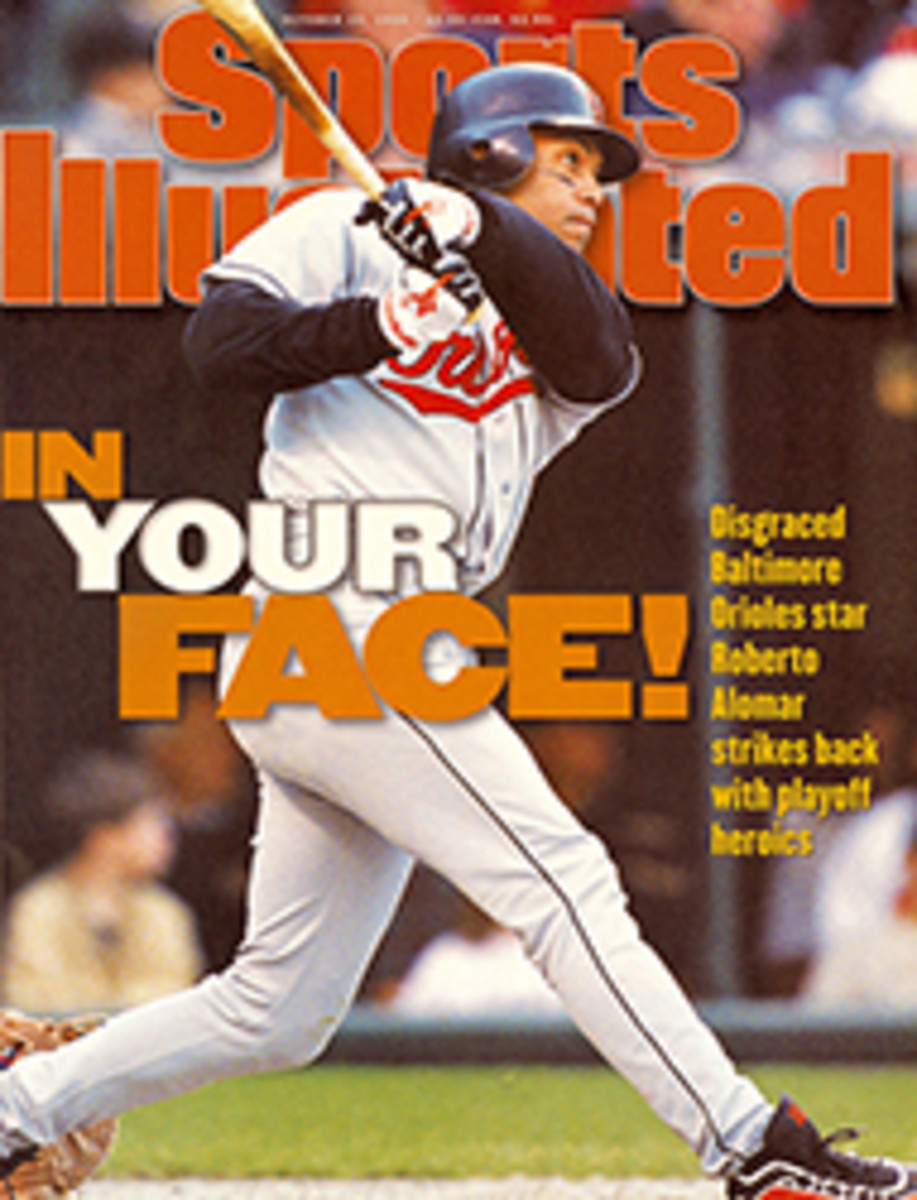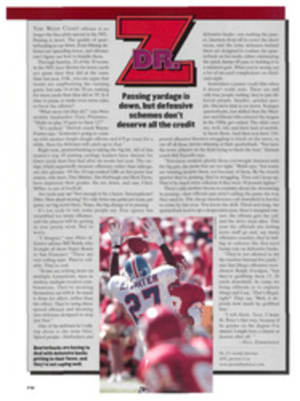
HOW ZEBRAS GET THEIR STRIPES THE NFL RECRUITS OFFICIALS WHO THRIVE UNDER STRESS--ON AND OFF THE FIELD
During a Chicago Bears-Detroit Lions game at Soldier Field in
1972, referee Norm Schachter told Bears linebacker Dick Butkus
that if he didn't lay off Lions quarterback Greg Landry,
Schachter would penalize him for roughing the passer. Butkus
went ballistic, kicking dirt, spitting, cussing and waving his
finger at Schachter. For a few plays Schachter let Butkus vent
his ire. Finally Schachter said, "If you don't shut up, I'll
bite your head off."
"Go right ahead," Butkus said with a snort. "Then you'll have
more brains in your stomach than you do in your head."
Wrong, Dick. Contrary to popular opinion, NFL officials aren't
dumber than coaches, players and fans. In fact, they may be the
smartest guys on the field. Officiating in the NFL is no weekend
hobby for football dilettantes.
A high-profile, high-pressure career isn't a prerequisite for
carrying an NFL whistle, but it certainly helps. Monday through
Friday, umpire Jim Quirk, a nine-year veteran of officiating,
sells U.S. government securities as a senior vice president at
Sanwa Securities in New York City. Quirk, 56, makes transactions
worth anywhere from a few million to a half-billion dollars at a
time, dozens of times a day. In his office--a desk on Sanwa's
frenetic trading floor--are four phones, a computer, order
sheets, financial journals and an NFL rule book.
"Guys making calls in the NFL usually have intense careers that
involve lots of tough decision-making," says Quirk. "As a
trader, if you don't react with authority, you'll get
steamrollered--and go broke. It's the same deal in the NFL. If
you don't think and act like you're the best, the man in
control, you'll get crucified."
The NFL employs 112 officials, recruited from among the best
50,000 refs who work in organized football every year. No
unsolicited applications, please. "If somebody is worthy of
working for us, we'll go after him," says Jerry Seeman, the
league's director of officiating and himself a former NFL ref
with 16 years on-field experience.
The league has 50 scouts who hunt for new blood in Division I
and I-AA college conferences. Each fall the scouts keep close
tabs on about 150 college officials, each of whom needs at least
five years in a conference to qualify. That number is whittled
to 15 in the off-season. Candidates give the league details of
their officiating and of their personal and employment
histories. Then they come to New York City for a two-hour
interview with the three NFL supervisors at league headquarters.
Finally the league gives them rigorous psychological exams and
makes background checks. The NFL's 40-man private investigation
arm, made up mostly of former FBI agents, interviews friends,
neighbors and coworkers of the prospective officials, looking
for any history of gambling, drinking or unsavory associations.
From the group of 15 candidates, the league usually hires six
new whistle-blowers each year to replace retiring officials and
the few who are fired. The pay is generous. In the regular
season officials earn $1,325 to $4,009 per game, depending on
experience. Playoff games pay $9,800 and the Super Bowl,
$11,900. The weekly travel benefits include first-class airfare,
concierge-level hotel rooms and a per diem of $205 for the first
night and $155 for the second. Upon retirement officials receive
a pension of $150 a month for each year of service, provided
that they have worked at least 10 years.
But it's not the money that attracts guys to NFL officiating.
It's the thrill of being part of the country's most popular
professional sports league. "At first I was awed by it all,"
says Red Cashion, 64, a 24-year veteran of NFL refereeing and
the chairman emeritus of ANCO Insurance, a company he cofounded
in Texas in 1955. "But the enormity of it all makes you work
that much harder."
Most officials say that they devote more time during the season
to the NFL than to their full-time jobs. Almost daily they
review game tapes, study the 134-page rule book and talk on the
phone with other officials and staff members at the league
office. Once a week they do a take-home rules exam that is not
graded but is meant to keep them sharp. Most refs also work out
daily, running and doing various types of cardiovascular
exercise. That adds up to about 25 hours a week.
Each game takes another two days of their time. Officials must
arrive in town by noon the day before a game for the weekly crew
meeting. On Aug. 31 the crew working the opening-day game
between the San Francisco 49ers and the New Orleans Saints met
in room 4096 at the San Francisco Airport Marriott. For five
hours the seven men (referee, umpire, linesman, side judge,
field judge, line judge and back judge) reviewed game films and
went over the referees report from Seeman.
Topics they discussed included how to recognize chop blocks; how
to inflate and rub down the 36 new balls (12 for each half and
another dozen in reserve) allotted for each game; how to
distinguish running into the kicker from roughing the kicker;
and what to watch for on sideline passes. "Feet, then ball,"
Seeman said on a video showing sideline grabs. "Eyes on the feet
until they land, then the ball. Feet. Ball."
Each week Seeman and his 10-person staff grade officials by
reviewing tapes of all games and then ranking the refs, by
position, in relation to each other. The top-rated officials at
each position are eligible for postseason assignments. "Peer
pressure is our Number 1 motivating factor," says Al Jury, 55, a
back judge and veteran of four Super Bowls who recently retired
from the California Highway Patrol after 28 years as a
patrolman. "We all want to get to the Super Bowl, and to get
there you can't be a wimp. You've got to stand up and make the
call. I don't think fans appreciate how hard that is."
"It's easy for the world to have an opinion on a call," says
Seeman. "They get instant replay. But officials have to make
split-second judgments on things that a thousand replays won't
always give convincing proof of. Our statistics show officials
are correct 95% of the time, and that's pretty darn good."
Avoiding injury is another challenge for officials. Nobody knows
this better than umpire Art Demmas. Demmas, 62, is the southern
coordinator for the College Football Hall of Fame and is the
most senior official in the NFL, now in his 29th year. Umpire is
the most dangerous of the seven officiating positions, because
umps line up five yards behind the defensive line. In 1992, in a
game between the Green Bay Packers and the Cincinnati Bengals,
Demmas put his hands on his knees and got ready for a play. What
happened next is a bad and blurry memory for the ump. There was
a running play up the middle, right at him. He was trapped in a
pack of linebackers. The ballcarrier plowed into the
linebackers. Somebody's helmet hit Demmas in the chest. The
result: a cracked sternum and severely bruised lungs.
After surgery to repair the damage, Demmas developed pneumonia.
His lungs filled with fluid, and they have continued to do so
every few days ever since. Because of this condition, called
bronchiectasis, Demmas is on antibiotics all the time, and his
wife pounds his back to help drain his lungs. "That stuff comes
with the job," says Demmas. "I never thought seriously about
quitting."
There are some lighter moments on the field as well. Former
Bears running back Walter Payton is, by all accounts, the
officials' alltime favorite player. Sweetness, as Payton was
nicknamed, loved teasing officials, and one of his favorite
games was untying their shoelaces. Early in one game Payton
surreptitiously undid Frank Sinkovitz's laces so many times that
by halftime the official was fuming. Early in the second half,
Payton landed on the bottom of a pileup. As Sinkovitz knelt down
to break it up, he felt a hand on his foot. He looked down and
saw an arm sticking out of the heap, the fingers on his laces.
"Gotcha!" yelled Sinkovitz.
Payton howled with laughter. He said, "What took you so long,
Frankie?"
Not every player is an angel, however. Some teams, including the
Arizona Cardinals, the Miami Dolphins, the Buffalo Bills and the
Oakland Raiders, are notorious for playing so aggressively that
officials must always be on guard. "Everything's on edge with
Oakland," says one official. "They are very tough to work."
The toughest thing for an official is to mistakenly impose a
penalty. The cardinal rule of NFL officiating is that a no-call
is infinitely better than a bad call. Cashion found this out at
the end of the first half of Super Bowl XX in 1986. Chicago had
driven deep into New England Patriots territory. With 21 seconds
remaining in the half, Bears quarterback Jim McMahon scrambled
down to the three-yard line. Immediately the Bears lined up, and
with three seconds left in the half, their center snapped the
ball before Cashion could put it back in play.
Cashion correctly called the Bears for delay of game. But he
forgot to run 10 seconds off the clock as a penalty for
deliberate clock-stopping in the final two minutes of a half.
That would have left no time on the clock. Instead Kevin Butler
booted a 24-yard field goal. Fortunately Cashion's error didn't
affect the game's outcome; the field goal put the Bears up 23-3
in what would be a 46-10 blowout. Still, Cashion was furious
with himself.
"We work so damn hard to make every call," Cashion says. "That's
why I can't help but chuckle inside every time I overhear
somebody say, 'Why doesn't the NFL use full-time officials?'"
COLOR PHOTO: MICHAEL ZITO/SPORTSCHROME EAST/WEST Currency trader Quirk is confident making quick calls. [Jim Quirk]
COLOR PHOTO: DAVID BOSS/NFL PHOTOS Retired CEO Cashion (above) and former lawman Jury are both Super Bowl veterans. [Red Cashion]
COLOR PHOTO: PAUL SPINELLI/NFL PHOTOS [See caption above--Al Jury]

